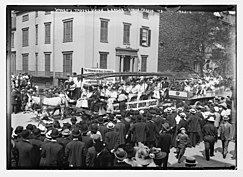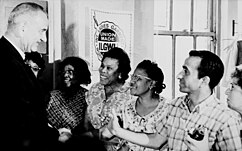The Women's Trade Union League of America (WTUL) was formed in November 1903 after three meetings at a convention for the American Federation of Labor. [2] Mary Morton Kehew became president, Jane Addams the vice-president, Mary Kenney O'Sullivan the secretary, and Mary McDowell the executive board. [2]
An economic downturn in early 1904 caused union membership decline, and as a result, the WTUL struggled at its formation. [2] The WTUL also discovered it was difficult to organize women due to lack of union knowledge and family obligations. [2] Despite initial difficulty in organizing, the WTUL supported spontaneous strikes when the International Ladies' Garment Workers' Union (ILGWU) lacked funding. [2] The WTUL offered groups of strikers help in exchange for their loyalty to the American Federation of Labor (AFL). [2] Though the AFL affiliation caused issues within the league, the WTUL insisted on following the AFL's policies in order to retain status as reputable unionists. [2]
A body of strong strike leaders and organizers, including Leonora O'Reilly and Josephine Casey, was developed within the WTUL by 1906. [2] Allies of the WTUL helped to organize walkouts, boycotts, walk picket lines, and raise funds for the league. [2]
In 1909 the WTUL purchased a large house at 43 East Twenty-second Street to be used as a meeting place for all women unionists, as proposed by Mary Dreier, the WTUL's New York leader [3] Prior, many women's trade unions had met in small, dirty meeting halls, which led the WTUL to believe that the spacious meeting place would be more inviting and attractive for smaller unions. [2]
Outreach
To reach out and inform women in the workforce, the WTUL wrote the text New World Lessons for Old World People, which contained essays and stories with subjects pertaining to working conditions, conflicts due to ethnicity, and laws within factories. [2] They also formed the Good Health League, which held lectures to inform women about their personal well-being, and how their poor working conditions affected their health. [2] Though many saw work as a temporary transition period between childhood and marriage, the WTUL attempted to urge women to view themselves as independent wage earners. [2] Rallies and marches were held by the WTUL to protest the police brutality women faced while picketing. [2]
Until 1955 the WTUL remained active. [2]




